
Podocnemididae is a family of pleurodire (side-necked) turtles, once widely distributed. Most of its 20 genera and 30 species are now extinct. Seven of its eight surviving species are native to South America: the genus Peltocephalus, with only one species ; and the genus Podocnemis, with six living species of South American side-necked river turtles. There is also one genus native to Madagascar: Erymnochelys, the Madagascan big-headed turtle, whose single species E. madagascariensis.
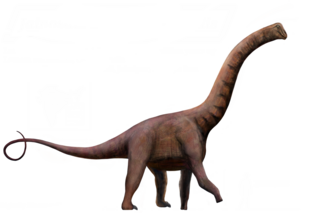
Jainosaurus is a genus of titanosaurian sauropod dinosaur of India and wider Asia, which lived in the Maastrichtian. It is thought to have been about the same size as its contemporary relative Isisaurus, measuring 18 metres (59 ft) long and weighing 15 metric tons. The humerus of the type specimen is 134 centimetres long.

Isisaurus is a genus of titanosaurian dinosaur from the Late Cretaceous Lameta Formation of India and Pab Formation of Pakistan. The genus contains a single species, Isisaurus colberti.
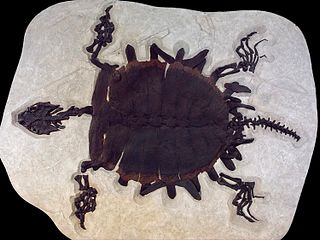
Axestemys is an extinct genus of softshell turtle that lived from the Late Cretaceous to the Eocene in western North America and Europe.

Bothremydidae is an extinct family of side-necked turtles (Pleurodira) known from the Cretaceous and Cenozoic. They are closely related to Podocnemididae, and are amongst the most widely distributed pleurodire groups, with their fossils having been found in Africa, India, the Middle East, Europe, North America and South America. Bothremydids were aquatic turtles with a high morphological diversity, indicative of generalist, molluscivorous, piscivorous and possibly herbivorous grazing diets, with some probably capable of suction feeding. Unlike modern pleurodires, which are exclusively freshwater, bothremydids inhabited freshwater, marine and coastal environments. Their marine habits allowed bothremydids to disperse across oceanic barriers into Europe and North America during the early Late Cretaceous (Cenomanian). The youngest records of the group are indeterminate remains from Saudi Arabia and Oman, dating to the Miocene.
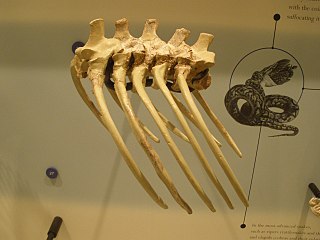
Madtsoia is an extinct genus of madtsoiid snakes. It is known from the Eocene of Argentina, the Paleocene of Brazil, the Late Cretaceous (Maastrichtian) of India, and the Late Cretaceous (Maastrichtian) of Madagascar. The type species was the largest with an estimated length of 9–10 m (30–33 ft), and the other three species were smaller. A 5.1 m (17 ft) long M. madagascariensis would have weighed 50 kg (110 lb), but an isolated specimen suggests that this species reached 8 m (26 ft) in maximum length.
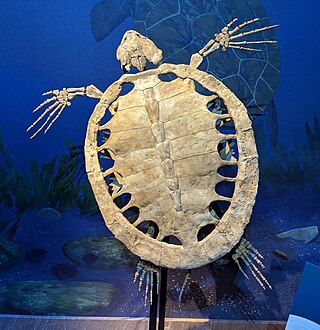
Euclastes is an extinct genus of sea turtles that survived the Cretaceous–Paleogene mass extinction. The genus was first named by Edward Drinker Cope in 1867, and contains three species. E. hutchisoni, was named in 2003 but has since been reassigned to the genus Pacifichelys, while E. coahuilaensis named in 2009 was reassigned as Mexichelys coahuilaensis in 2010.
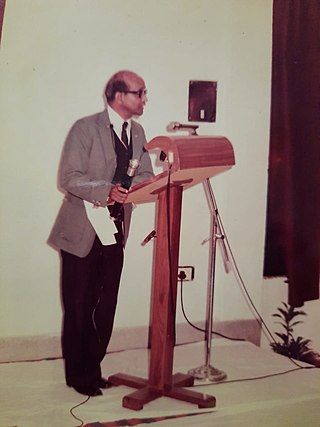
Sohan Lal Jain is an Indian paleontologist, who worked for 33 years at the Indian Statistical Institute, Kolkata. The large herbivorous sauropod dinosaur genus Jainosaurus, was named in his honour after it was identified as a distinct genus although initially thought to be a species of Antarctosaurus. His other major contributions to paleontology were in the study of sauropod braincases and some fossil turtles.
Hutchemys is an extinct genus of softshell turtles from the late Cretaceous to the late Paleocene of New Mexico, Montana, Wyoming, Utah, and North Dakota, United States. It was first named by Walter G. Joyce, Ariel Revan, Tyler R. Lyson and Igor G. Danilov in 2009, and the type species is Hutchemys rememdium. H. rememdium is known from the holotype YPM PU 16795, which consists of a nearly complete postcranial skeleton, and from the referred specimen YPM PU 16781, found in the Ekalaka Member of the Fort Union Formation, Montana. Another referred specimen, YPM PU 14985, was found in the Cedar Point Quarry, Wyoming. The second species, H. arctochelys, is known from the holotype YPM PU 16319, a nearly complete carapace, and from the paratypes YPM PU 16320, YPM PU 16321, YPM PU 16322, YPM PU 16238. All specimens of H. arctochelys were recovered from the same quarry of the Tongue River Member, Fort Union Formation, near Burns Mine of Montana. A possible third species is represented by the unnamed specimen UCMP 130000 from the Paleocene Tullock Formation of Montana. Aspideretes? nassau (YPM PU 11566) from the Fort Union Formation, Duffy's Ranch of Sweet Grass County, Montana was also assigned to Hutchemys sp. A fourth species of Hutchemys, Hutchemys walkerorum, has been uncovered from the Hell Creek Formation of North Dakota. H. walkerorum is known from the holotype BDM 063, identified by the discovery and assembly of portions of its carapace. The fossil of H. walkerorum suggests that it was the only Hutchemys to live exclusively during the late Cretaceous era.
Palatobaena is an extinct genus of baenid turtle. It was first named by Gaffney in 1972 and the type species is Palatobaena bairdi. It based on a fragmentary skull from the Fort Union Formation of the Bighorn Basin of Wyoming. The two other species are P. gaffneyi and P. cohen which existed in Hell Creek Formation, North Dakota during the late Cretaceous period.

Trionyx is a genus of softshell turtles belonging to the family Trionychidae. In the past many species in the family were classified in this genus, but today T. triunguis, the African or Nile softshell turtle, is the only extant softshell still classified as Trionyx. The other species still assigned to this genus are only known from fossils. T. triunguis is a relatively large, aquatic piscivore.

Baenidae is an extinct family of paracryptodiran turtles known from the Early Cretaceous to Eocene of North America. While during the Early Cretaceous they are found across North America, during the Late Cretaceous they are only found in Laramidia, having disappeared from Appalachia. The majority of lineages survived the K-Pg Extinction, but the family was extinct by the latest Eocene. The name of the type genus, Baena, appears to be of Native American origin. They are primarily found in freshwater deposits, and are considered to be aquatic, with a largely generalist habit.

The Oulad Abdoun Basin is a phosphate sedimentary basin located in Morocco, near the city of Khouribga. It is the largest in Morocco, comprising 44% of Morocco's phosphate reserves, and at least 26.8 billion tons of phosphate. It is also known as an important site for vertebrate fossils, with deposits ranging from the Late Cretaceous (Cenomanian-Turonian) to the Eocene epoch (Ypresian), a period of about 25 million years.

Kallokibotion is an extinct genus of stem-turtle from the Upper Cretaceous, known from fossils found in Romania. One species is known, Kallokibotion bajazidi, which was named by Franz Nopcsa after his lover Bajazid Doda. It literally means 'beautiful box of Bajazid'; Nopcsa chose the name because, in the words of British palaeontologist Gareth Dyke, "the shape of the shell reminded him of Bajazid's arse". A second undescribed species is known from the Santonian of Hungary.
Paleontology or palaeontology is the study of prehistoric life forms on Earth through the examination of plant and animal fossils. This includes the study of body fossils, tracks (ichnites), burrows, cast-off parts, fossilised feces (coprolites), palynomorphs and chemical residues. Because humans have encountered fossils for millennia, paleontology has a long history both before and after becoming formalized as a science. This article records significant discoveries and events related to paleontology that occurred or were published in the year 2017.
This list of fossil reptiles described in 2020 is a list of new taxa of fossil reptiles that were described during the year 2020, as well as other significant discoveries and events related to reptile paleontology that occurred in 2020.
This list of fossil reptiles described in 2021 is a list of new taxa of fossil reptiles that were described during the year 2021, as well as other significant discoveries and events related to reptile paleontology that occurred in 2021.
Jainemys is an extinct genus of bothremydid pleurodiran turtle that has been found in the Lameta Formation, India. Originally described by Sohan Lal Jain in 1977 under the name "Carteremys" pisdurensis, the species was transferred to the new genus Jainemys by Joyce & Bandyopadhyay in 2020.

Sahonachelys is an extinct genus of pelomedusoid turtle from the Late Cretaceous (Maastrichtian) Maevarano Formation of Madagascar. The genus contains a single species, Sahonachelys mailakavava.
This list of fossil reptiles described in 2022 is a list of new taxa of fossil reptiles that were described during the year 2022, as well as other significant discoveries and events related to reptile paleontology that occurred in 2022.












